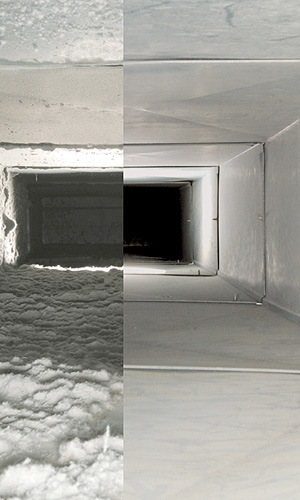
Air Duct Maintenance
Clean air ducts can mean cleaner, healthier air in your home. Regardless of whether you get your air ducts professionally cleaned or you clean them yourself, a regular maintenance program can help minimize contamination of your air ducts and improve the indoor air quality in your home. Air duct preventative maintenance revolves around two factors, limiting the amount of foreign particles (dust, pollen, insects, insect droppings, rodent droppings, pet dander, etc.) that enters your ducts and your heating and cooling system and preventing moisture from entering the system.
Dryer vent cleaning is a separate matter but is equally important.
Steps to limit the amount of foreign particles in your system:
- Use the most efficient air filter you can afford as recommended by the manufacturer of your heating or cooling system.
- Change your air filter regularly. How often depends on where you live, whether you have pets, whether someone smokes in the home and how much your system runs.
- Be sure all filters are in place (many systems use more than one filter) and that they fit properly such that air cannot bypass the filters.
- Whenever you have your heating or cooling system serviced, ask the service technician to clean the cooling coils and drain pans.
- Do not operate your system and seal the return and supply vents during major home renovations that will generate a lot of dust.
- Dust and vacuum your home regularly. Ideally use a high efficiency (HEPA) vacuum with the highest efficiency filter you can afford.
Moisture in duct work is never a good thing. It can lead to mold, bacteria and fungi growth which can cause health problems. Moisture in air ducts is not all that uncommon and can be caused by heating and cooling system or by other factors such as leaks in pipes or in your roof.
Research indicates that condensation on or near cooling coils of air conditioners is a major contributor of moisture in duct work. Condensation is normal and is caused when the temperature of air in the system is cooler than the dew point temperature of surrounding air. Newer systems, when functioning properly, are designed to remove this condensation without any contamination of the ducts. Improperly installed systems, improperly serviced systems and malfunctioning systems can increase the amount of damage caused by condensation.
Steps to prevent moisture in your air ducts:
- Repair any water leaks and water damage quickly and thoroughly.
- Condensation coils, when functioning properly, remove water from the air and drain pans remove the water from the system. Both components should be inspected regularly. Drain pans should drain completely so standing water can indicates the pan is not functioning properly. The drain pan should be free of debris that could affect its ability to drain properly.
- Ducts should be sealed and insulated whenever they are in areas that are not air conditioned such as attics, crawl spaces or garages. This will help reduce condensation by reducing the temperature difference between the air in the ducts and the air directly next to the duct.
- When replacing an air conditioner be sure the new unit is suited for your size home. An air conditioner that is too large will tend to cycle on an off more frequently which reduces its effectiveness at removing moisture from the air.
Waiting to have your air ducts cleaned until there is a problem such as mold being present often means family members have already been exposed to the health hazard. This is why routine maintenance of your air ducts is critical, either by a professional air duct cleaner or by preventative steps taken by the homeowner.



